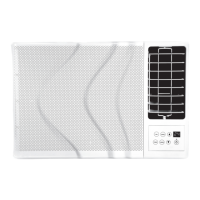PGD4, PGS4, Series G, H WPG4 Series D, H Ultra Low NOx: Installation Instructions
Manufacturer reserves the right to change, at any time, specifications and designs without notice and without obligations.
3
Ducts passing through an unconditioned space must be insulated and
covered with a vapor barrier.
If a plenum return is used on a vertical unit, the return should be ducted
through the roof deck to comply with applicable fire codes.
Read unit rating plate for any required clearances around ductwork.
Cabinet return-air static shall not exceed -.25 IN. W.C.
Step 4 – Provide Clearances
IMPORTANT: The unit must be secured to the curb by installing
screws through the bottom of the curb flange and into the unit base rails.
When installing large base units onto the common curb, the screws must
be installed before allowing the full weight of the unit to rest on the curb.
A minimum of six screws are required for large base units. Failure to
secure unit properly could result in an unstable unit. See Warning near
Rigging/Lifting information and accessory curb instructions for more
details.
The required minimum operating and service clearances are shown in
Fig. 3 - Fig. 6. Adequate combustion, ventilation and condenser air must
be provided.
IMPORTANT: Do not restrict outdoor airflow. An air restriction at
either the outdoor-air inlet or the fan discharge may be detrimental to
compressor life.
The condenser fan pulls air through the condenser coil and discharges it
through the top grille. Be sure that the fan discharge does not recirculate
to the condenser coil. Do not locate the unit in either a corner or under an
overhead obstruction. The minimum clearance under a partial overhang
(such as a normal house overhang) is 48-in. (1219 mm) above the unit
top. The maximum horizontal extension of a partial overhang must not
exceed 48-in. (1219 mm).
Do not place the unit where water, ice, or snow from an overhang or roof
will damage or flood the unit. Do not install the unit on carpeting or
other combustible materials. Slab-mounted units should be at least 2 in.
(51 mm) above the highest expected water and runoff levels. Do not use
unit if it has been under water.
Step 5 – Rig and Place Unit
Rigging and handling of this equipment can be hazardous for many
reasons due to the installation location (roofs, elevated structures, etc.).
Only trained, qualified crane operators and ground support staff should
handle and install this equipment.
When working with this equipment, observe precautions in the literature,
on tags, stickers, and labels attached to the equipment, and any other
safety precautions that might apply.
Training for operators of the lifting equipment should include, but not be
limited to, the following:
1. Application of the lifter to the load, and adjustment of the lifts to
adapt to various sizes or kinds of loads.
2. Instruction in any special operation or precaution.
3. Condition of the load as it relates to operation of the lifting kit, such
as balance, temperature, etc.
Follow all applicable safety codes. Wear safety shoes and work gloves.
Inspection
Prior to initial use, and at monthly intervals, all rigging shackles, clevis
pins, and straps should be visually inspected for any damage, evidence
of wear, structural deformation, or cracks. Particular attention should be
paid to excessive wear at hoist hooking points and load support areas.
Materials showing any kind of wear in these areas must not be used and
should be discarded.
Rigging/Lifting of Unit (See Fig. 8)
Lifting holes are provided in base rails as shown in Fig. 3 - Fig. 6.
1. Leave top shipping skid on the unit for use as a spreader bar to
prevent the rigging straps from damaging the unit. If the skid is not
available, use a spreader bar of sufficient length to protect the unit
from damage.
2. Attach shackles, clevis pins, and straps to the base rails of the unit.
Be sure materials are rated to hold the weight of the unit (See
Fig. 8).
3. Attach a clevis of sufficient strength in the middle of the straps.
Adjust the clevis location to ensure unit is lifted level with the
ground.
After the unit is placed on the roof curb or mounting pad, remove the top
skid.
WARNING
!
UNIT FALLING HAZARD
Failure to follow this warning could result in personal injury or death.
Never stand beneath rigged units or lift over people.
WARNING
!
PROPERTY DAMAGE HAZARD
Failure to follow this warning could result in personal injury/death or
property damage.
When straps are taut, the clevis should be a minimum of 36 in. (914
mm) above the unit top cover.
WARNING
!
UNIT FALLING HAZARD
Failure to follow this warning could result in personal injury or death.
Large base units must be secured to common curb before allowing full
weight of unit to rest on curb. Install screws through curb into unit base
rails while rigging crane is still supporting unit.

